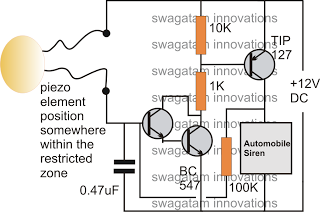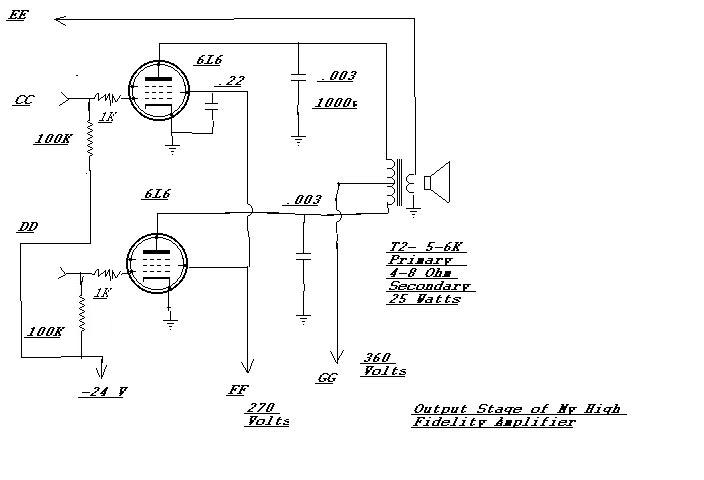
make these simple cheap home burglar

The following article discusses a few very simple intrusion detector circuits, or burglar alarm circuits. The presented designs are straightforward yet highly effective in their functions. The triggering stage may consist of a voltage/current amplifier stage combined with a relay driver stage, along with a timer stage to maintain the triggering switch in the ON position even after the threat is eliminated, thereby enhancing safety. Generally, PIR sensors, which detect body warmth, are incorporated in most high-end burglar alarms; however, this article aims to achieve reasonably similar results using ordinary arrangements for the sensor stage in the proposed circuits. The simplest design involves using an ordinary thin wire conductor laid across a restricted area, such that any intruder breaking the wire will trigger the alarm. The entire system can be installed over a door or restricted entrance. If an intruder attempts to break in, the disturbance of the door will activate the connected piezo sensor and the preceding alarm circuit. Additionally, a toy laser beam can effectively serve as an alarm sensor. In this setup, the restricted area is covered by laser beams reflected across the area via precisely angled mirrors, with the final reflection directed toward an LDR trigger circuit. If an intruder attempts to enter the premises, they will block at least one of the reflections, interrupting the laser path to the LDR.
The described intrusion detector circuits utilize basic components to create effective burglar alarms. The first circuit employs a thin wire conductor, which acts as a tripwire. When an intruder crosses this wire, it breaks the circuit, sending a signal to the amplifier stage. The voltage/current amplifier amplifies this signal, which then activates a relay driver stage. This relay can control a more powerful alarm system, such as a siren or piezo buzzer, ensuring that the alarm is loud enough to alert nearby individuals.
In addition to the wire-based system, the use of laser beams as a detection method is an innovative approach. The laser beam setup involves a laser diode emitting a beam that is reflected by mirrors positioned at strategic angles. The reflected beam is directed toward a Light Dependent Resistor (LDR) that serves as a sensor. When the laser beam is interrupted by an intruder, the light reaching the LDR is diminished, causing a change in resistance. This change is detected by the triggering circuit, which activates the alarm system in a manner similar to the wire conductor method.
Both systems can be enhanced with a timer stage that ensures the alarm remains activated for a set duration, even after the initial trigger has been removed. This feature is particularly useful in scenarios where the intruder may quickly leave the area after breaking the tripwire or blocking the laser beam. By implementing these straightforward yet effective designs, the circuits provide a reliable means of intrusion detection, suitable for various applications in home security.The following article discusses a few very simple intrusion detector circuits, or simply burglar alarm circuits. The presented designs are simple yet extremely effective with the functions. The triggering stage may consist of a voltage/current amplifier stage rigged with a relay driver stage along with a timer stage for keeping the triggering swit
ched ON even after the threat is eliminated, for increased safety. Generally PIR sensorswhichwork bydetectingbody warmth are incorporated in most hi-end types of burglar alarms, however here well try to implement reasonably similar results yet use ordinary arrangements for the sensor stage in the proposed circuits. This is probably the simplest one among all. As shown in the diagram, the sensor is an ordinary thin wire conductor which is laid across therestrictedarea in such a way that anybody intruding the place gets caught up against the conductor and in the course breaks it up.
Theentiresystem may be fixed over the door or therestrictedentrance. If an intruder tries to break in, the door would be disturbed instantly activating the connected piezo sensor, and theprecedingalarm circuit. This toy laser beam can be effectively implemented as an alarm sensor. As shown in the figure, the restricted area may be swarmed by laser beams reflectedacrossthe area via accurately angled mirrors.
The final reflection gets directed toward an LDR trigger circuit. In case an intruder tries to trespass the premise, the person would block at least one of the reflections, interrupting the laser passage over the LDR. 🔗 External reference
The described intrusion detector circuits utilize basic components to create effective burglar alarms. The first circuit employs a thin wire conductor, which acts as a tripwire. When an intruder crosses this wire, it breaks the circuit, sending a signal to the amplifier stage. The voltage/current amplifier amplifies this signal, which then activates a relay driver stage. This relay can control a more powerful alarm system, such as a siren or piezo buzzer, ensuring that the alarm is loud enough to alert nearby individuals.
In addition to the wire-based system, the use of laser beams as a detection method is an innovative approach. The laser beam setup involves a laser diode emitting a beam that is reflected by mirrors positioned at strategic angles. The reflected beam is directed toward a Light Dependent Resistor (LDR) that serves as a sensor. When the laser beam is interrupted by an intruder, the light reaching the LDR is diminished, causing a change in resistance. This change is detected by the triggering circuit, which activates the alarm system in a manner similar to the wire conductor method.
Both systems can be enhanced with a timer stage that ensures the alarm remains activated for a set duration, even after the initial trigger has been removed. This feature is particularly useful in scenarios where the intruder may quickly leave the area after breaking the tripwire or blocking the laser beam. By implementing these straightforward yet effective designs, the circuits provide a reliable means of intrusion detection, suitable for various applications in home security.The following article discusses a few very simple intrusion detector circuits, or simply burglar alarm circuits. The presented designs are simple yet extremely effective with the functions. The triggering stage may consist of a voltage/current amplifier stage rigged with a relay driver stage along with a timer stage for keeping the triggering swit
ched ON even after the threat is eliminated, for increased safety. Generally PIR sensorswhichwork bydetectingbody warmth are incorporated in most hi-end types of burglar alarms, however here well try to implement reasonably similar results yet use ordinary arrangements for the sensor stage in the proposed circuits. This is probably the simplest one among all. As shown in the diagram, the sensor is an ordinary thin wire conductor which is laid across therestrictedarea in such a way that anybody intruding the place gets caught up against the conductor and in the course breaks it up.
Theentiresystem may be fixed over the door or therestrictedentrance. If an intruder tries to break in, the door would be disturbed instantly activating the connected piezo sensor, and theprecedingalarm circuit. This toy laser beam can be effectively implemented as an alarm sensor. As shown in the figure, the restricted area may be swarmed by laser beams reflectedacrossthe area via accurately angled mirrors.
The final reflection gets directed toward an LDR trigger circuit. In case an intruder tries to trespass the premise, the person would block at least one of the reflections, interrupting the laser passage over the LDR. 🔗 External reference





